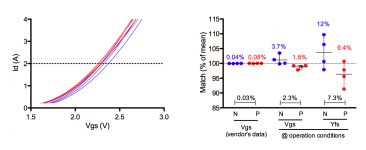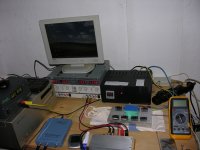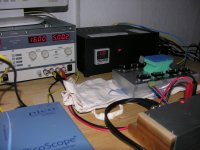> I have noticed in matching that some devices are more affected by changes in temperature than others.
That is precisely why I always insist, to the annoynace of some here, to match under operating conditions.
And of course I know why this is so. And I can give you a hint.
See if you can find any data at all on the Rthjc of Toshiba FETs.

Patrick
That is precisely why I always insist, to the annoynace of some here, to match under operating conditions.
And of course I know why this is so. And I can give you a hint.
See if you can find any data at all on the Rthjc of Toshiba FETs.
Patrick
I don't doubt you at all, but your setup is advanced and it's development is a cost you absorb. While not excellent, like your results, Nikon's measurements were stool good to very good. I think it all becomes more important in your implementation of an X version of the F5. I am thoroughly impressed by both of your efforts.
I think it all becomes more important in your implementation of an X version of the F5.
I think it is the other way around. The X version, in contrast to the single ended F5, should be immune to NP-offset induced distortion because of its balanced topology.
I think patrick actually posted a practical demonstration of this a few days ago.
While you may think the nikon1975 set is "good to very good" this is not really the case. The Yfs of the N-devices are all over the place and perfect P-devices, or a balanced topology, will not fix this.
Have you guys had the chance to test distortion specs using devices from different matching sources?
Most folks build amps here, listen and enjoy. Few go further and measure and tweak to get ultimate performance. While it makes perfect sense that others efforts are inferior to your own, what is the practical implications of the findings. What do they translate into in terms of performance. Clearly if I was trying to avoid the topic, I wouldn't post. The info ids great.
I think this introduces the beauty of P3 in Nelson's design. It does allow for some level of adjustment for less than stellar output devices.
Most folks build amps here, listen and enjoy. Few go further and measure and tweak to get ultimate performance. While it makes perfect sense that others efforts are inferior to your own, what is the practical implications of the findings. What do they translate into in terms of performance. Clearly if I was trying to avoid the topic, I wouldn't post. The info ids great.
I think this introduces the beauty of P3 in Nelson's design. It does allow for some level of adjustment for less than stellar output devices.
Last edited:
With the limited time that I have and the many task that I still want to do,
I rather spend my time on perfecting things, rather than finding out what I can get away with.
My personal choice.
It is perhaps better to post the question to Nelson.
He makes a living from this, so he needs to be practical.
All these will be less obvious for a circuit with global negative feedback.
It will be much more observable in circuits without.
Which is of course what I want to do next .....
You are of course welcome to obtain "bad" FETs from Nic and test them to prove matching is not critical.
At least that is as far as measurement goes.

Patrick
I rather spend my time on perfecting things, rather than finding out what I can get away with.
My personal choice.
It is perhaps better to post the question to Nelson.
He makes a living from this, so he needs to be practical.
All these will be less obvious for a circuit with global negative feedback.
It will be much more observable in circuits without.
Which is of course what I want to do next .....
You are of course welcome to obtain "bad" FETs from Nic and test them to prove matching is not critical.
At least that is as far as measurement goes.
Patrick
With the limited time that I have and the many task that I still want to do,
I rather spend my time on perfecting things, rather than finding out what I can get away with.
My personal choice.
It is perhaps better to post the question to Nelson.
He makes a living from this, so he needs to be practical.
All these will be less obvious for a circuit with global negative feedback.
It will be much more observable in circuits without.
Which is of course what I want to do next .....
You are of course welcome to obtain "bad" FETs from Nic and test them to prove matching is not critical.
At least that is as far as measurement goes.
Patrick
I applaud your effort in designing a high performance amp while having to take into consideration the ablilities of those assembling them. I am not trying to be difficult, but simply trying to ascertain just how much difference the ideal matching makes. Many have talked about how Nelson amps sound better. Perhaps htis is one fo the reason why. ONce again, I have nothing but respect for your effort. Just learning.
To Buzzforb :
Your questions are legitimate.
But I cannot possibly answer all questions, especially they demand a huge effort.
The question you post will cost us at least 40 working hours, not to speak of money.
So we have to prioritise. And this one we have to pass.
Patrick
Your questions are legitimate.
But I cannot possibly answer all questions, especially they demand a huge effort.
The question you post will cost us at least 40 working hours, not to speak of money.
So we have to prioritise. And this one we have to pass.
Patrick
Saw your post. Was actually asking about PP NN PP NN match (More interested about. Good to know about much matching for quad sets.
As far as I can understand buying stats of FETs that are in the matching peaks for the p and n channel separately should increase match quality no? and if floating X fixes the PN match problem then should a P-N match be a priority at all?
What are the benifits of close matching between channels for this amp? How would this translate to matching for a 16+ channel HOA system?
As far as I can understand buying stats of FETs that are in the matching peaks for the p and n channel separately should increase match quality no? and if floating X fixes the PN match problem then should a P-N match be a priority at all?
What are the benifits of close matching between channels for this amp? How would this translate to matching for a 16+ channel HOA system?
To Buzzforb :
Your questions are legitimate.
But I cannot possibly answer all questions, especially they demand a huge effort.
The question you post will cost us at least 40 working hours, not to speak of money.
So we have to prioritise. And this one we have to pass.
Patrick
Cool. Just didnt know if you had done it already. I remember reading you has built other iterations of the F5. From what little I have done on the GB front, I am very aware of the time you must commit to this thing. Good luck anf thank for the bit of education.
If you want 16 channels you can go for nn & PP, as you said.
They will cost much less, but you need to talk to Nic.
If left & right channels are not identical, you might end up with (slightly) different amount of feedback, and different harmonic content.
So they will sound different. The question is how much and whether audible.
Patrick
They will cost much less, but you need to talk to Nic.
If left & right channels are not identical, you might end up with (slightly) different amount of feedback, and different harmonic content.
So they will sound different. The question is how much and whether audible.
Patrick
Here are two pictures of the equipment I use for data collection. The first one shows the working environment:
I collect the raw data and send them to Nic for further analysis and processing.
- USB scope connected to computer and FET tester
- Power supplies for FET tester (16V, current limit set to 5A, output switched off) and 12V heating circuit (delivering 2,5 A to heating block via SSR in PID controller case)
- PID controller case and heating block
- Multimeter with thermocouple for additional temperature monitoring
I collect the raw data and send them to Nic for further analysis and processing.
Attachments
...
For those who have already bought NP-matched (not PP-matched only) devices from Zhou I am likely to be able to help in finding significantly better matched 2SK1530s for their 2SJ201s.
I will likely do this free of charge for people who are going to get matched sets from me, but this service may also (FETs permitting....) be extended to others.
More about this later.
Nic
Hi Nic,
As someone who has several sets from Zhou and Blues, I would be interested in obtaining better matches if possible (free or otherwise).
Yes - this might still be possible.Hi Nic,
As someone who has several sets from Zhou and Blues, I would be interested in obtaining better matches if possible (free or otherwise).
First thing is that you PM the Vgs values written on Zhou's 2SJ201 FETs and I will let you know later. This value has to be high enough to enter my unmatched 2SK130 region (the one from nikon1575 is high enough and I am going to fix his set).
For the FETs from Blues I cannot help as even the 2SJ201 in the sample I have seen are very variable.
Nic,
IMHO you need to be cautious about extrapolating any conclusions you make with one set of data.
You have measured one set from Vendor Z and one set from Vendor B.
Those measurements do not necessarily extend to other sets from them respectively.
I applaud your generosity.
But if you want to help others to rematch, there is no other way than to send them all to heinz1 for measurement,
and then pool them in together with your devices.
But the approach is correct.
If the Vgs lies outside your range then there is not much you can do.
Patrick
IMHO you need to be cautious about extrapolating any conclusions you make with one set of data.
You have measured one set from Vendor Z and one set from Vendor B.
Those measurements do not necessarily extend to other sets from them respectively.
I applaud your generosity.
But if you want to help others to rematch, there is no other way than to send them all to heinz1 for measurement,
and then pool them in together with your devices.
But the approach is correct.
If the Vgs lies outside your range then there is not much you can do.
Patrick
Patrick,
that is of course all completely correct. I do mean improve, not make perfect. What I am saying is simply that the probability of having a decent PPPP-set is higher than having a decent NNNN-set. But still a lottery.
The 600+ 2SJ201 I have looked at for certain have a much tighter Yfs distribution and more similar Vgs change with temperature.
The only right way is of course to get the FETs to heinz1 and have a look at what can be done, with no guarantees and well understanding that we are not in the miracle business. This would obviously only be possible if heinz1 would agree to do it and in front of a reasonable compensation for his efforts.
We have now settled for the 26 perfect NNNNPPPP-sets and most should be able to finish their amps
We should have the time over the next months to investigate the possibility.
Nic
that is of course all completely correct. I do mean improve, not make perfect. What I am saying is simply that the probability of having a decent PPPP-set is higher than having a decent NNNN-set. But still a lottery.
The 600+ 2SJ201 I have looked at for certain have a much tighter Yfs distribution and more similar Vgs change with temperature.
The only right way is of course to get the FETs to heinz1 and have a look at what can be done, with no guarantees and well understanding that we are not in the miracle business. This would obviously only be possible if heinz1 would agree to do it and in front of a reasonable compensation for his efforts.
We have now settled for the 26 perfect NNNNPPPP-sets and most should be able to finish their amps
We should have the time over the next months to investigate the possibility.
Nic
- Status
- This old topic is closed. If you want to reopen this topic, contact a moderator using the "Report Post" button.
- Home
- Group Buys
- GB NP matched Toshiba 2SK1530/2SK201 for F5X


